Ampeg
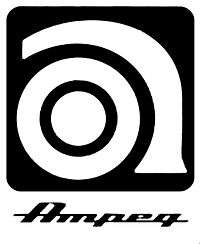 | |
Formerly | Michaels-Hull Electronic Labs |
|---|---|
| Private | |
| Industry | Musical instruments |
| Founded | 1946 |
| Founder |
Everett Hull, Stanley Michaels |
| Headquarters | Calabasas, California, United States of America |
Area served | Global |
| Products |
Bass & guitar amps Electric & acoustic upright basses pickups Bass guitars Electric guitars |
| Parent | Yamaha Guitar Group, Inc. |
| Subsidiaries | Dan Armstrong |
| Website | Ampeg.com |
Ampeg is a manufacturer of musical instruments, especially the musical instrument amplifier, established by Everett Hull and Stanley Michaels in 1946. Although the company specializes in the production of bass amplifiers (for bass guitars and double basses), they also manufacture guitar amplifiers. In the past, Ampeg also manufactured several instruments including pickups, double basses, bass guitars, and electric guitars.
Overview
History
Everett Hull, a pianist and bassist, and Stanley Michaels, an electrical engineer and amp technician, established Michaels-Hull Electronic Labs in Newark, New Jersey in 1946. Their first products were a pickup designed by Hull for upright bass, and instrument amplifiers that had minimal output distortion, which jazz musicians favored. The pickup was called the "Amplified Peg," which became "Ampeg." Michaels left the company in 1948, leaving it to Hull, who relocated to 42nd Street in Manhattan the following year and renamed it "The Ampeg Bassamp Company."
In 1956, Ampeg's name was simplified to "The Ampeg Company" which became "The Ampeg Company, Inc." when the company incorporated in 1959. In 1962, Ampeg relocated to Linden, New Jersey, and became a publicly owned company after an initial public stock offering the following year.
In September, 1967 Ampeg became a subsidiary of Unimusic, Inc. when the newly formed investor group acquired a majority share of Ampeg stock. Unimusic consisted of investors interested in capitalizing on opportunities in the highly fragmented music equipment manufacturing market of the time, not unlike CBS which owned Fender and Rhodes, or the later Norlin which at times owned various music instrument brands, including Gibson Guitars, Lowrey and Moog Music. Everett Hull was wrongly under the impression that the new owners would act more as a partnership; instead, his role within the company was reduced. He tendered his resignation in October, 1968.[1]
In 1971, Ampeg was acquired by Magnavox,[2] which also owned Selmer, the Band Instrument manufacturer, but was better known for televisions, radios and Hi-Fi systems.
In 1980, Ampeg was acquired by Music Technology, Inc. (MTI). MTI declared bankruptcy a few years later, and St. Louis Music (SLM) acquired the assets of Ampeg in 1986. SLM was subsequently bought by LOUD Technologies in 2005.[2]
Ampeg now
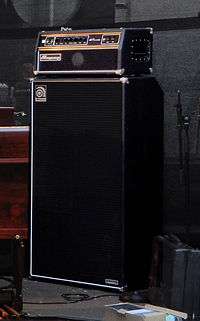
SVT Classic
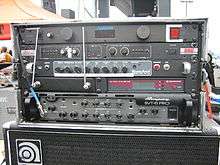
The current Ampeg company is mainly known in the field of bass amps. They also have a line of guitar amplifiers and a remake of the Dan Armstrong guitar and bass.
In 2005, Ampeg, and its parent company, St. Louis Music (also makers of Crate amps) was purchased by LOUD Technologies Inc. In March 2007, LOUD ceased production of Ampeg and Crate at the manufacturing facility in Yellville, Arkansas, outsourcing the manufacture of Ampeg and Crate to contract manufacturers in Asia.
In May 2018, the Ampeg brand was acquired from LOUD Technologies by Yamaha Guitar Group, Inc.[3]
Recent amplifiers (after 1990s)
In the mid-1990s, SLM issued several guitar amplifiers under the Ampeg name. Some of these, reissued under the "Diamond Blue Series" designation, used the names of vintage Ampeg amplifers (such as Jet and Reverberocket) and featured the bluish-colored diamond-checkerboard covering associated with Ampeg amps of the 1960s. The circuit designs of these amplifiers, however, were new. The Portaflex bass amp was also reissued, this time with updates to make them more appealing to modern-style bass players.
The Ampeg GVT series, introduced around 2010, is a series of tube amplifiers built in South Korea, noteworthy because they employ the Baxandall tone circuit.[4]
 SVT Classic:
SVT Classic:
SVT-350H (head), SVT-410HLF (cab.) SVT Pro:
SVT Pro:
SVT-3 Pro (head),
15E, 210AV (cabs.)- Portaflex:
PF-350 (class D head) .jpg) Diamond Blue:
Diamond Blue:
B-200R bass amp
Recent instruments (after 1990s)
In the mid- to late-1990s, Ampeg reissued the Baby Bass, the Horizontal Bass,[5] and the "See-Through" instruments, as well as wooden instruments based on the "See-Through" design.
Amplifiers
Innovations and characteristics
Ampeg holds six U.S. patents under the Ampeg brand name.
Ampeg Portaflex
In the late-1950s Jess Oliver invented[5] a combo amplifier with a chassis that could be inverted and tucked inside the speaker enclosure to protect the vacuum tubes. This combo bass amp was introduced in 1960 as the Portaflex, and remained a popular choice through the 1960s.
Characteristics
A particular characteristic of Ampeg amplifiers in the 1960s is that they were designed to be used for jazz and other types of music where distortion was not sought after — as Everett Hull had a major contempt for rock and roll music, and his hope that it being merely a "passing fancy" never materializing, had merely manifested his dismissive attitude towards the genre. Not only did he loathe the presence of rock musicians visiting the (then) New Jersey-based facility, but also his narrow-minded bias served as something of a corporate liability, in his apparent unwillingness to market Ampeg amps to rock musicians; as Ampeg didn't go out of its way to seek endorsements from pop/rock bands and musicians, despite plenty of them using Ampeg products at one time or another. The closest they came to a rock'n roll endorser at one point, was by way of Joe Long, a left-handed bass player of the Four Seasons, who played the company's Horizontal Bass. This was further compounded by the one chief competitor Hull disliked the most; Fender, as they continually bested Ampeg in overall sales.[5]
Hull also naively believed that the accordion was just as popular as ever, and denoted "accordion" jacks on certain amp models. Hull would grudgingly acknowledge rock'n roll music, via advertising copy for Ampeg's "Supercombo" bass amp, introduced in 1959.
Reverberocket
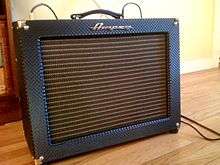
The Reverberocket would become another exception to that rule, as an amplifier with 6V6 -type power tubes which sounded "Fendery" and did break up in a way that rock and roll players could use.[6]
In 1961, Ampeg became the first company to incorporate reverberation (reverb) in an amplifier with its Reverberocket, which preceded Fender's Vibroverb amp by nearly two years.
Dan Armstrong
After Ampeg was sold to Unimusic in 1968, Dan Armstrong would be brought on board, and along with the opening of regional offices in places like Nashville, and the West Coast, the company's previously stodgy image would be dealt with, once and for all, especially with the creation of the all-new SVT amp, which would be "field-tested" by the Rolling Stones during their 1969 concert tour. Additionally, Keith Richards would be playing (at least part-time) Dan Armstrong's newly designed see-through body guitar.
Super Valve Technology
During the 1960s Ampeg only produced fairly low wattage combo amplifiers. Rock concerts were becoming increasingly large affairs and bigger amplifiers were needed. In 1969, Ampeg's Chief Engineer Bill Hughes designed the Super Valve Technology circuitry for the amplifier of the same name. At 85 lb (39 kg), the Ampeg SVT provided 300 watts of RMS power, considerably more than most other bass amplifiers of the era. The high power rating made the SVT a candidate for use in larger venues. The SVT saw widespread use by rock acts in the 1970s and is still considered by many to be the world standard reference bass amp. The SVT-VR (Vintage Reissue) is almost identical in design and construction and the closest thing to any of the original SVT models produced by Ampeg.
Collectability and playability

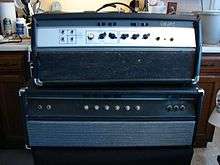
Ampeg V-4B (1970s) bass heads
Compared to the major brands Fender and Marshall, the collectability and playability of the guitar amps is a mixed affair. While vintage Fender amps consistently command high prices, Ampeg guitar amps such as the Reverberocket can often be found for prices atypical of vintage amplifiers.[6] In general, Ampeg guitar amps until 1964 are less desirable as they have a darker, cleaner sound even when pushed hard. With the introduction of the Galaxy line (Gemini, Mercury, Reverberocket) in 1964, treble boost circuits and spring reverbs were added, and higher wattage models (such as the 30 watt Gemini II) were made available. Original SVT bass amps are highly sought-after for their pleasing sound and were used by many professional bassists in the '70s. V series guitar amps (V2 and V4 heads along with the VT-40 and VT-22 combos) are sought after for the classic 70s crunchy but clean sound. The V4-B is another sought after bass amp head; it has the SVT pre-amp section mated to a 100 Watt power amp section.
 vintage Ampeg amps
vintage Ampeg amps
at RCA Studio B Gemini II G-15L (1965-1968)
Gemini II G-15L (1965-1968) GT-10 solid state guitar amp (1971-1980)
GT-10 solid state guitar amp (1971-1980)
Instruments and accessories
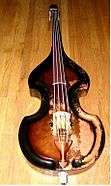

Ampeg also manufactured (or had manufactured for them) lines of quirky but distinctive instruments to complement their amplifiers.
Baby Bass
Baby Bass, introduced around 1962, was an electric upright bass with a full-size wooden neck and a cello-sized Uvex plastic body (not fiberglass, as is often stated). The design was purchased from Zorko, re-engineered by Jess Oliver, and manufactured in a corner of Ampeg's Linden, New Jersey factory. It appeared in Ampeg's price list until about 1970, and overall, weren't terribly popular; the exception being with some bassists in Latin Salsa-music bands, on account of the instrument's reputedly "thoompy" sound.
Guitars by Burns
In the early 1960s, Ampeg-branded guitars and basses were produced by Burns of London, but these instruments did not sell well, because the cost of importing the instruments made them too expensive compared to Fenders and Gibsons. Baldwin's purchase of Burns in 1965 ended the association with Ampeg.
Horizontal Bass and Devil Bass
- 1966–1969, designed by Dennis Kager, etc.

_see-through_electric_guitar_-_MIM_PHX.jpg)
In 1966, Ampeg introduced their home-built line of long-scale "Horizontal Basses" (aka "scroll" or "f-hole" basses), both fretted and fretless (reputed to be the first production fretless electric bass). Some with different bodies were produced as the "Devil Bass" with distinctive horns, but the circuitry was identical. Originally using a transducer below the bridge, they were redesigned around 1968 to use a conventional magnetic pickup. At the same time, short-scale fretted and fretless basses, with magnetic pickups, were also produced.[5]
Dan Armstrong "see-through"
In 1969 the Horizontal Basses were replaced by the Dan Armstrong-designed and -built "see-through" guitars and basses (aka "Plexi,[7] "Lucite" or "crystal" named after various brand names of acrylic glass). The guitars incorporated slide-in user-changeable pickups, and the short-scale basses used two stacked coils with a "pan" pot to gain a very wide range of tones. The transparent lucite bodies were Armstrong's original idea and contributed to long sustain but were very heavy. Ampeg's production of the "see-through" instruments ended in 1971 due to financial disagreements between Armstrong and Ampeg over amplifier designs. It was also during the Unimusic era that Ampeg became a distributor of Grammer acoustic guitars, a small company founded by country singer-guitarist Billy Grammer, probably best known for his 1958 crossover hit, "Gotta Travel On", and his appearances on entertainer Jimmy Dean's TV show.
Hagström distribution
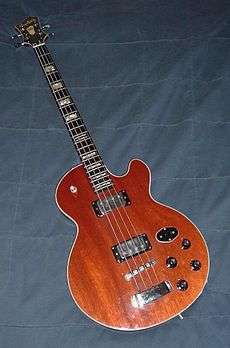
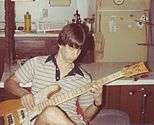
In 1971, Ampeg was acquired by Magnavox, and it would lead to a distributorship deal with the Swedish guitar company, Hagström. In the 1975, Ampeg and Hagström collaborated to develop their first guitar/synthesizer hybrid using a contact of string with fret, and in 1976, Swede Patch 2000 was released. The Patch 2000 consisted of a Hagström Swede with frets wiring, Ampeg Patch 2000 Pedals, and an external synthesizer was required (Steiner-Parker Microcon was designed for it).[8]
Stud series
In the mid-1970s, Ampeg had a line of Japanese-made guitars and basses under the "Stud" name. The guitars included the Stud, Heavy Stud, and Super Stud, and the basses included the Big Stud and Little Stud. The Studs were knock-offs of popular Fender and Gibson instruments (although the Fender copies sported rather incongruous 3/3 and 2/2 guitar and bass headstocks). Some of the Stud instruments were poorly built (e.g. the plywood bodies and necks on the Little Stud), while others had good-quality features (e.g., gold-plated hardware on the Super Stud).
Effects pedals & Accessories
Ampeg also produced effects pedals, including stand-alone reverb units in the 60s, the Scrambler (distortion) from 1969 (a resurgence in interest resulted in an updated Scrambler being reissued in 2005 along with Sub-Blaster (octaver) that produced a note one octave down), the Phazzer (phaser) from the mid- to late-70s, and a line of nine stomp boxes produced in Japan in the mid-80s.
There were also Ampeg branded accessories that included covers, picks, strings, straps, polish, as well as two practice amps, the Sound Cube and the Buster (a Pignose clone). Currently, Ampeg mostly offers covers, some outerwear, and a few other accessories with their logo.
References
- ↑ Hopkins, Gregg (1999). Ampeg: The Story Behind The Sound. Hal Leonard. pp. 115–127.
- 1 2 Fjestad 2010.
- ↑ "YAMAHA GUITAR GROUP ANNOUNCES ACQUISITION OF LEGENDARY BASS AMP BRAND, AMPEG" (PDF). Yamaha Guitar Group. May 10, 2018. Retrieved May 10, 2018.
- ↑
Thompson, Art. "Ampeg GVT5-110, GVT15H, and GVT52-112". Guitar Player (December 2011): 96&ndash, 102.
|access-date=requires|url=(help) - 1 2 3 4 Hopkins & Moore 1997.
- 1 2 Hunter, Dave. "The Ampeg R-12-R Reverberocket". Vintage Guitar (January 2013): 58&ndash, 60. Retrieved 19 November 2012.
- ↑ "New Ampeg Dan Armstrong Plexi Bass". Ampeg. March 10, 2008. Archived from the original on July 7, 2011.
- ↑ "Patch 2000". Hagstrom.org.uk.
Bibliography
- Books
- Hopkins, Gregg; Moore, Bill (1999). Ampeg: The Story Behind the Sound. Milwaukee: Hal Leonard. ISBN 0-7935-7951-1.
- Fjestad, Zachary R. (2009). "Ampeg/Dan Armstrong Ampeg". Blue Book of Electric Guitars (12 ed.). Blue Book Publications. ISBN 978-1-886768-93-2.
- Fjestad, Zachary R. (2010). "Ampeg". Blue Book of Guitar Amplifiers (4 ed.). Blue Book Publications. ISBN 978-1-936120-05-5.
- Official site
- "Ampeg History". Ampeg. Retrieved 2014-08-30.
Ampeg History Links : 300 Watts Of Bass Amp Glory: The SVT Story / Through The Years, Clearly: Dan Armstrong Series / Ampeg: The Story Behind the Sound / Ampeg Through the Years / Ampeg Milestones
- Magazines
- Hopkins, Gregg; Moore, Bill. "Ampeg Horizontal Basses: From Liden, NJ. to Linden Avenue, Burbank, CA". Vintage Guitar (March 1997). Archived from the original on 2007-11-14.
- Fjestad, Zachary (August 17, 2010). "Ampeg B-15N Portaflex". Premier Guitar.
"Much like all of Ampeg’s amps, the B-15 underwent constant change, and the B-15 was replaced by the B-15N in 1961. In 1962, Ampeg updated the B-15N with a solid-state rectifier called the B-15NB and introduced their famous “blue check” vinyl covering to their entire amp line. Ampeg went back to a tube rectifier and changed to a printed circuit board in 1964 (B-15NC). This model lasted until mid 1965, when they introduced the B-15NF with fixed bias tubes and a single-baffle cabinet. ...", "... Ampeg went through numerous ownership changes over the next two decades with Unimusic taking over in 1967, Magnavox in 1971, and MTI in 1980. / St. Louis Music bought Ampeg in 1985 and finally returned some stability and respect to the brand. The company also reissued the B-15N Portaflex with blue check covering in 1995. Ampeg was purchased by LOUD Technologies in 2005, and in 2010, they introduced the new Heritage Series that is produced in the US."
- Others (web sites, etc.)
- "Dan Armstrong: The Man and His Guitars". DanArmstrong.org. Archived from the original on 2014-09-29.
External links
| Wikimedia Commons has media related to Ampeg. |